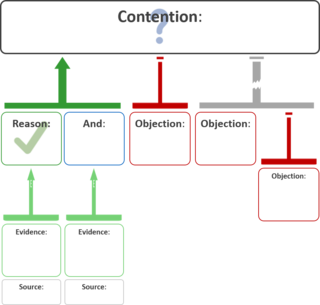
Ad hominem, short for argumentum ad hominem, is a fallacious argumentative strategy whereby genuine discussion of the topic at hand is avoided by instead attacking the character, motive, or other attribute of the person making the argument, or persons associated with the argument, rather than attacking the substance of the argument itself. The terms ad mulierem and ad feminam have been used specifically when the person receiving the criticism is female.
A slippery slope argument (SSA), in logic, critical thinking, political rhetoric, and caselaw, is a consequentialist logical device in which a party asserts that a relatively small first step leads to a chain of related events culminating in some significant effect. The core of the slippery slope argument is that a specific decision under debate is likely to result in unintended consequences. The strength of such an argument depends on the warrant, i.e. whether or not one can demonstrate a process that leads to the significant effect. This type of argument is sometimes used as a form of fear mongering, in which the probable consequences of a given action are exaggerated in an attempt to scare the audience. The fallacious sense of "slippery slope" is often used synonymously with continuum fallacy, in that it ignores the possibility of middle ground and assumes a discrete transition from category A to category B. In a non-fallacious sense, including use as a legal principle, a middle-ground possibility is acknowledged, and reasoning is provided for the likelihood of the predicted outcome.
A straw man is a form of argument and an informal fallacy based on giving the impression of refuting an opponent's argument, while actually refuting an argument that was not presented by that opponent. One who engages in this fallacy is said to be "attacking a straw man."

Begging the question is an informal fallacy that occurs when an argument's premises assume the truth of the conclusion, instead of supporting it. It is a type of circular reasoning: an argument that requires that the desired conclusion be true. This often occurs in an indirect way such that the fallacy's presence is hidden, or at least not easily apparent.
A fallacy is the use of invalid or otherwise faulty reasoning, or "wrong moves" in the construction of an argument. A fallacious argument may be deceptive by appearing to be better than it really is. Some fallacies are committed intentionally to manipulate or persuade by deception, while others are committed unintentionally due to carelessness or ignorance. The soundness of legal arguments depends on the context in which the arguments are made.
Abductive reasoning is a form of logical inference which starts with an observation or set of observations then seeks to find the simplest and most likely explanation for the observations. This process, unlike deductive reasoning, yields a plausible conclusion but does not positively verify it. Abductive conclusions are thus qualified as having a remnant of uncertainty or doubt, which is expressed in retreat terms such as "best available" or "most likely". One can understand abductive reasoning as inference to the best explanation, although not all uses of the terms abduction and inference to the best explanation are exactly equivalent.
Circular reasoning is a logical fallacy in which the reasoner begins with what they are trying to end with. The components of a circular argument are often logically valid because if the premises are true, the conclusion must be true. Circular reasoning is not a formal logical fallacy but a pragmatic defect in an argument whereby the premises are just as much in need of proof or evidence as the conclusion, and as a consequence the argument fails to persuade. Other ways to express this are that there is no reason to accept the premises unless one already believes the conclusion, or that the premises provide no independent ground or evidence for the conclusion. Begging the question is closely related to circular reasoning, and in modern usage the two generally refer to the same thing.
Inferences are steps in reasoning, moving from premises to logical consequences; etymologically, the word infer means to "carry forward". Inference is theoretically traditionally divided into deduction and induction, a distinction that in Europe dates at least to Aristotle. Deduction is inference deriving logical conclusions from premises known or assumed to be true, with the laws of valid inference being studied in logic. Induction is inference from particular premises to a universal conclusion. A third type of inference is sometimes distinguished, notably by Charles Sanders Peirce, distinguishing abduction from induction, where abduction is inference to the best explanation.
In philosophy, practical reason is the use of reason to decide how to act. It contrasts with theoretical reason, often called speculative reason, the use of reason to decide what to follow. For example, agents use practical reason to decide whether to build a telescope, but theoretical reason to decide which of two theories of light and optics is the best.
Argumentation theory, or argumentation, is the interdisciplinary study of how conclusions can be reached through logical reasoning; that is, claims based, soundly or not, on premises. It includes the arts and sciences of civil debate, dialogue, conversation, and persuasion. It studies rules of inference, logic, and procedural rules in both artificial and real world settings.

In informal logic and philosophy, an argument map or argument diagram is a visual representation of the structure of an argument. An argument map typically includes the key components of the argument, traditionally called the conclusion and the premises, also called contention and reasons. Argument maps can also show co-premises, objections, counterarguments, rebuttals, and lemmas. There are different styles of argument map but they are often functionally equivalent and represent an argument's individual claims and the relationships between them.
In logic and philosophy, an argument is a series of statements, called the premises or premisses, intended to determine the degree of truth of another statement, the conclusion. The logical form of an argument in a natural language can be represented in a symbolic formal language, and independently of natural language formally defined "arguments" can be made in math and computer science.
Henry Johnstone Jr. (1920–2000) was an American philosopher and rhetorician known especially for his notion of the "rhetorical wedge" and his re-evaluation of the ad hominem fallacy. He was Professor of Philosophy at Pennsylvania State University (1952–1984) and began studying Classics in the late 1970s. He was the founder and longtime editor of the journal Philosophy and Rhetoric and edited the Journal of Speculative Philosophy.
John Hayden Woods is a Canadian logician and philosopher. He currently holds the position of Director of the Abductive Systems Group at the University of British Columbia (UBC) and is The UBC Honorary Professor of Logic. He is also affiliated with the Group on Logic, Information and Computation within the Department of Informatics at King's College London where he has held the Charles S. Peirce Visiting Professorship of Logic position since 2001.
Howard Kahane was an American professor of philosophy at Bernard M. Baruch College in New York City. He was noted for promoting a popular, and non-mathematical, approach to logic, now known as informal logic. His best known publication in that area is his textbook Logic and Contemporary Rhetoric: The Use of Reason in Everyday Life, now at 11th edition; the 12th edition was published in 2014.

Logic is the systematic study of the form of valid inference, and the most general laws of truth. A valid inference is one where there is a specific relation of logical support between the assumptions of the inference and its conclusion. In ordinary discourse, inferences may be signified by words such as therefore, hence, ergo, and so on.
As the study of argument is of clear importance to the reasons that we hold things to be true, logic is of essential importance to rationality. Arguments may be logical if they are "conducted or assessed according to strict principles of validity", while they are rational according to the broader requirement that they are based on reason and knowledge.





